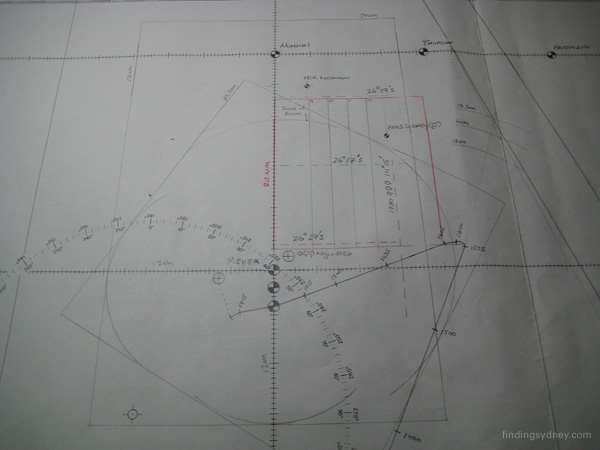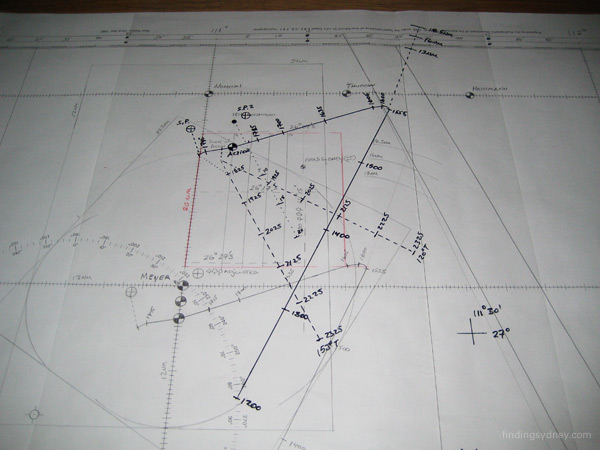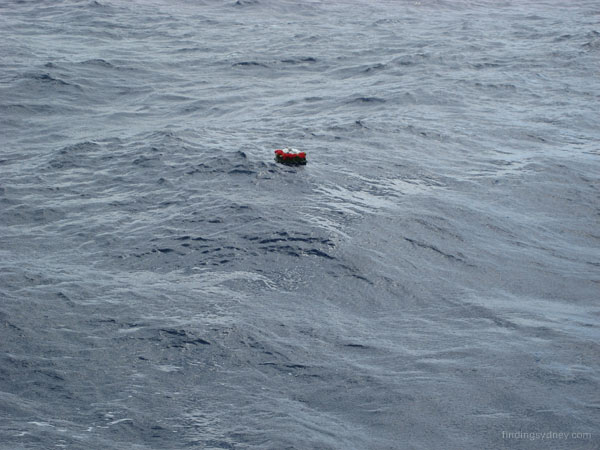David Mearns - Search Director, The Finding Sydney Foundation
The day began very early for all of us today. Actually for the past few days there hasn't been much difference between days and nights as they have all rolled into one long marathon session. Given what we have achieved in the 5 days since last Wednesday when we found Kormoran and the scene of the battle I wouldn't have wanted to miss a single second for having my eyes closed. Anyhow, we started at 5am for the final high-resolution sonar track over Sydney's wreck using the SM30 sonar. After another successful track the SM30 sonar was recovered in order to make way for its higher frequency sibling, the AMS60. Over the next two days more high-resolution sonar tracks are planned in order to accurately map all pieces of wreckage in preparation for the ROV video investigations that will begin next week.
Two key members of our search team have been the DOF surveyors Nigel Meikle and Steve Bagnell. They have really excelled over the past couple of days making sure that our navigational tracks for all the high-resolution sonar runs were precisely placed to get the best sonar image possible. Nigel and Steve's challenge, working in collaboration with the Williamson off-line processor Mike Kelly and the vessel's officers of the watch, is to drive the sonar down a precise track with as much as 9,000 metres of cable out. It is equivalent to trying to thread a needle from about 10-feet away.
There has been a fair amount of comment and surprise about how fast we located the wrecks, especially as most of our whole first week at sea was lost due to technical problems and bad weather. Considering that I truly felt the search could become prolonged and last as long as 45 days, I myself am impressed with how quickly we found the wrecks - but not completely surprised. Right from the start I was quite confident in the quality and veracity of the German accounts about where the action took place, even though there were many other researchers who strongly took an opposing view. It would be impossible for me to fully explain my research and plotting methodology in a simple blog like this, so perhaps the best thing is to show pictures of my actual reconstructed navigational plot and corresponding search boxes.
The one bit of analysis I would like to mention, which I think did help in finding the wrecks as quickly as we did, was a leeway drift analysis which was literally completed the day before we departed Geraldton. This analysis attempts to use the known pick-up position of the first life-raft recovered after Kormoran sank and an estimate of the winds and ocean currents over the 82 hours the life-raft was drifting to back-track to a probable sinking position for Kormoran. The analysis sounds simple and straight forward, but in fact it is very complex because of the difficulty in estimating the actual conditions that prevailed 67 years ago. I was helped in this analysis by three experts I would like to acknowledge here.
Len van Burgel, with assistance from the Australian Bureau of Meteorology, conducted an incredibly thorough estimate of wind conditions that constituted a major improvement over similar studies done decades ago; Dr. David Griffin, Research Scientist and CSIRO project leader of Bluelink II based in Hobart, used his Bluelink dataset on ocean currents to estimate their effect on the life-raft's drift; and Art Allen of the U.S. Coast Guard's Office of Search and Rescue provided helpful advice on leeway factors. I am extremely grateful for their assistance and professional advice.

Above Photograph - David Mearn's navigational reconstruction outlining the larger 1,768 sqnm search box for the Kormoran search and the smaller 360 sqnm search box for Sydney in red pencil. The final wreck and battle site locations are also plotted.

Above Photograph - This picture shows the overlay of Kormoran and Sydney's tracks used by David Mearns to assess different navigational scenarios by moving the overlay over the chart.

Above Photograph - Electric Pictures cinematographer Ullrich Krafzik and Lieutenant John Perryman read the order of service.

Above Photograph - David Mearns casts a commemorative wreath over the transom.

Above Photograph - The commemorative wreath drifts over the wreck of HSK Kormoran.
Glenys McDonald - Director, The Finding Sydney Foundation (Observer)
At 5.15am we were coming up to another parallel pass on the wreck of HMAS Sydney. Before us lay, without any shadow of doubt, a light cruiser. What appeared to be substantial damage to the bow of the ship became a focus for attention and further analysis.
Later we began the long exercise of bringing up the SM30 fish. By 11.30am we were once again alongside the Kormoran, and John Perryman conducted a simple and moving service for the 80 German sailors who lost their lives in this place on 19 November 1941. Ullrich Krafzik, the German born cameraman from Electric Pictures read the naval ode, and David Mearns laid a wreath.
Although it was noisy against the ship’s engines, which couldn’t be stopped at this point in time, all the team who were able to assemble, were on the back deck. We adjourned to the mess room where David read to the whole ship’s company the congratulations and well wishes from Prime Minister Rudd and the chairman of Finding Sydney Foundation, Ted Graham.
I spoke of the many messages of thanks we had received from the families of the crew lost in HMAS Sydney. It seemed from their messages that the whole nation was awash with emotion and tears at our news and I passed on the families words of gratitude.
Late in the afternoon the SM60 was deployed for a test run and a technical hitch saw it returned once more to the ship. Later tonight we hope to begin collecting high density sonar of the Kormoran before moving on to the battle site and lastly tomorrow we will be back with Sydney, where we will conduct another service.
John Perryman - Senior Naval Historian (Observer)
With today’s dawn came a feeling of great expectation, knowing that news of yesterday’s remarkable discovery would soon be broken.
However, we still had work to do and this involved conducting a final high resolution run over Sydney’s wreck with the SM30 side scan sonar. At 05:21 we commenced our pass, and what a pass it was. Before long we were rewarded with an amazing vista of Sydney’s wreck casting a near perfect acoustic shadow onto the seabed. The high points and low points of this shadow allowed David Mearns to gauge both height and breadth of the shipwreck and also make a number of other important observations. The concentration of high and low points grouped together in the centre of the wreck was one of the distinguishing features we were looking for and characteristic of the wreck being a ‘man of war’. Soon the debris field also came into view and again a large piece of wreckage was visible. These images were immediately transferred ashore via the internet.
With the run completed at 05:58 our thoughts again turned to the impending announcement. Because of the two hour time difference between Western Australia and the eastern states and territories we didn’t have long to wait, and it was with an enormous sense of pride and satisfaction that we learned that the official announcement concerning our discovery of HMAS Sydney had been made.
Before long the enormity of the announcement became apparent to us as we followed its progress via the internet. At this point my thoughts turned to the relatives of those lost in Sydney and in particular those who have supported our collective efforts throughout this historic endeavour.
Meanwhile the SM30 tow fish was recovered for the last time. The plan now is to switch to the AMS60 which we will use to sweep both of the wreck sites and the battle position in an attempt to obtain sonar images of an even higher resolution. We then steered north to the Kormoran’s position which would be the starting point of a southerly run back to Sydney’s location using the AMS60.
As we arrived in Kormoran’s position our thoughts turned to commemoration as this was likely to be the last opportunity during this phase of the operation to conduct a service in this location to commemorate the fallen Kriegsmarine personnel who died in Kormoran. Having now changed into a uniform more befitting the occasion I led a short but solemn unofficial service which culminated in the laying of a wreath over Kormoran’s wreck, the playing of the Last Post followed by one minute’s silence.
As we now make our way south to the site of Sydney’s wreck we are preparing a similar order of service to commemorate Sydney’s gallant crew and it is likely that this will be held tomorrow.
Currently the AMS60 is being prepared for deployment over our stern in readiness for the first of this evening’s sonar passes over Kormoran’s hull.
IMPORTANT NOTICE: The Material (including photographs) available in the "Press Room" section of this Website may be used/reproduced unaltered by your organisation (unless stated otherwise within the content description) subject to the terms and conditions set out in the Legal Section AND any Material (including photographs) which you use/reproduce must credit the source as "The Finding Sydney Foundation" and, as an option, you may also link the source statement with the website address http://www.findingsydney.com/.